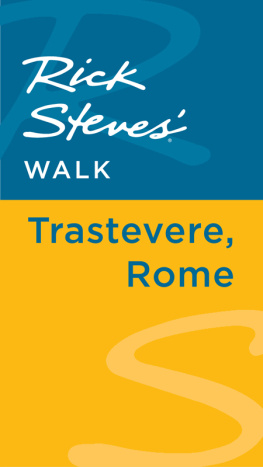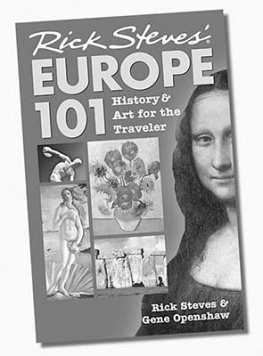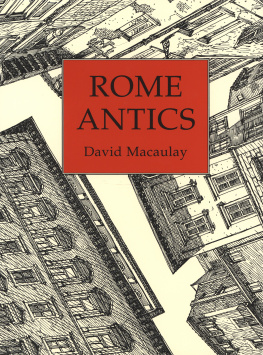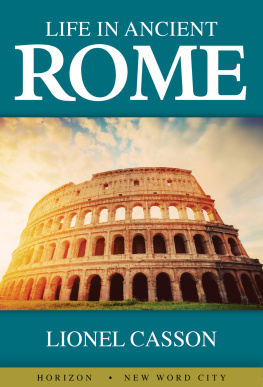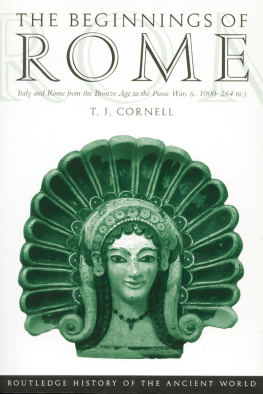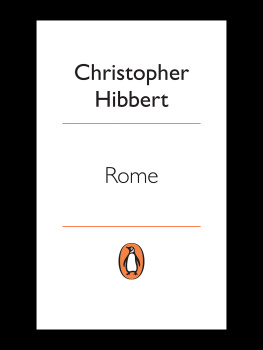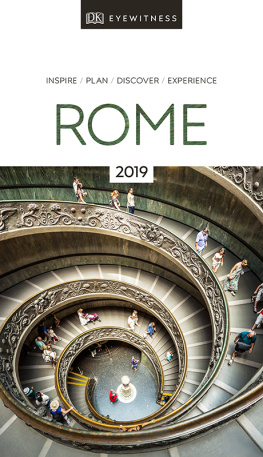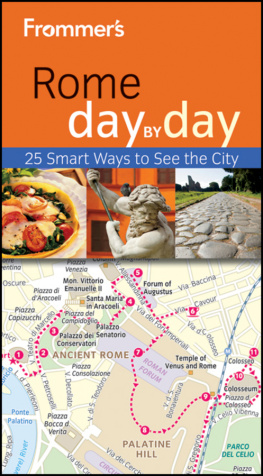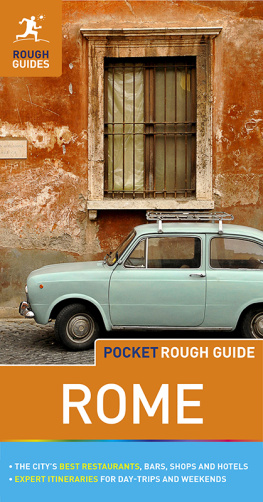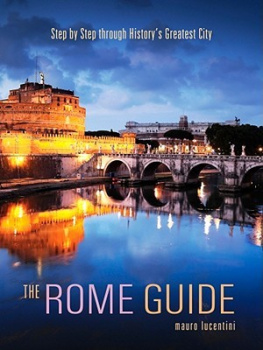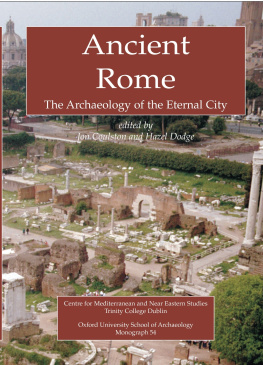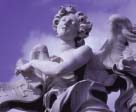
The principal sights
Ara Pacis
Arch of Constantine
Baths of Caracalla
Baths of Diocletian
Campidoglio and statue of Marcus Aurelius
Campo de Fiori
Cancelleria
Castel SantAngelo
Colosseum
Corso
Crescenzi House
Farnesina
Fountain of the Rivers
Ghetto
Horse Tamers
Imperial Palace on the Palatine
Ludus Magnus
Mamertine Prison
Mausoleum of Constantina
Palazzo Farnese
Palazzo Venezia
Pantheon
Piazza Navona
Porta Maggiore
Pyramid of Caius Cestius
Quirinal Palace
Roman Forum
S. Andrea della Valle
S. Carlino
S. Cecilia
S. Clemente
S. Cosimato
S. Giovanni in Laterano
S. Lorenzo fuori le Mura
S. Luigi dei Francesi
S. Maria degli Angeli
S. Maria in Ara Cli
S. Maria del Popolo
S. Maria Maggiore
S. Maria in Trastevere
S. Maria della Vittoria (Berninis St. Teresa)
St. Peters
Michelangelos Piet
S. Prassede
S. Pietro in Vincoli (Michelangelos Moses)
Spanish Steps
Tempietto of Bramante
Trajans Forum and Column
Trevi Fountain
Theatre of Marcellus
Vatican
Augustus of Prima Porta
Laocon
Stanze of Raphael
Sistine Chapel
Via Condotti
Villa Borghese & Borghese Gardens
Overleaf: street maps >




(*) On the two Fiumicino Airport lines, see p. 663
Previous 2 pages: Transportation Map of Central Rome
Right: Metro and Area Light Railways
Overleaf: Minibuses Serving Restricted-Traffic Zone
All courtesy of ATAC, Rome


Minibuses do not operate along Via del Corso and Via del Babuino between 15:00 and 21:00 on Sat. and between 9:00 and 19:00 on Sun. and holidays. Minibuses 117 and 119 limit their run to Piazza San Silvestro on weekends; 117 does not operate on Sun. The theatre minibus, 116T operates only on weekday evenings.
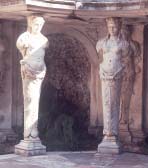
This book is dedicated
to the memory of
Paola Lucentini

This edition first published in 2012 by
INTERLINK BOOKS
An imprint of Interlink Publishing Group, Inc.
46 Crosby Street, Northampton Massachusetts 01060
www.interlinkbooks.com
Copyright Mauro, Eric, and Jack Lucentini, 2006 and 2012
All rights reserved.
Library of Congress Cataloging-in-Publication Data
Lucentini, Mauro.
The Rome guide : step by step through historys greatest city/by
Mauro Lucentini with Eric J. Lucentini and Jack Lucentini.
p. cm.
Includes bibliographical references and index.
ISBN 978-1-56656-836-4 (pbk.)
1. Rome (Italy)--Guidebooks. 2. Historic sites--Italy--Rome--Guidebooks. 3. Historic buildings--Italy--Rome--Guidebooks. 4. Rome (Italy)--Buildings, structures, etc.-- Guidebooks. 5. Walking--Italy--Rome--Guidebooks. 6. Rome (Italy)--History. 7. Art-- Italy- -Rome--History. 8. Architecture--Italy--Rome--History. I. Lucentini, Eric J. II. Lucentini, Jack. III. Title.
DG804.L77 2010 914.56320493--dc22 2010026634
Translation of sonnets by G. G. Belli Mauro Lucentini
All internal diagrams and maps Mauro Lucentini
Map on p. 560 courtesy of Prof. R. Meneghini
Image on p. 604 courtesy Prof. Marina Piranomonte AFSAR
Rome transportation maps reprinted by permission of ATAC, Rome
All photos by Cesare DOnofrio courtesy of Bibliotheca Hertziana,
Planck Institut fr Kunstgeschichte, Rome
Images from the plastic model of Rome by L. Gismondi in the Museo della Civilt Romana,
courtesy of Sovraintendenza ai Beni Culturali, Rome
Thanks to Alexander Fyjis-Walker for permission to use the Pallas Athene
edition layout and digital files
Printed and bound in the United States of America
To request our complete 48-page full-color catalog, please call us toll free at
1-800-238-LINK or visit our website at www.interlinkbooks.com
Acknowledgements
We would like to thank the librarians, editors, curators, archologists and others who helped make this book possible. Priceless technical assistance came from Diana Abrashkin, AIA, of Boston, and archologist Marina Piranomonte of Romes Sovrintendenza alle Belle Arti. For their advice and help we are indebted to Robert Bernstein, former chairman of Random House; Professor Jane Ginsburg of Columbia University; Mario Gori-Sassoli of Romes Istituto Nazionale per la Grafica; the late Hans Heinrich Coudenhove-Kalergi of London; Cheryl Hurley of the Library of America; Inge Heckel of the New York Academy of Interior Design; and Mark Piel of the New York Society Library.
We owe a special debt to the late historian and archologist Cesare DOnofrio of Rome for sharing his profound love and scholarly knowledge of his city with us, and to the Biblioteca Hertziana for generously making available to us the wonderful photographs of Rome that Mr. DOnofrio took over the years, and which appear (many of them for the first time) throughout this book.
Finally we wish to thank friends and family who patiently listened to our endless prattle about Rome and cheered us on, among them Carlo Fruttero, the late Franco Lucentini, Baroness Olga von Kollar, John and Mary Gibbons, Prince Carlo Massimo, Robert and Dina McCabe, Paul and Chantal Cannon, David Olan, Dotty Attie, Sarah Schulte and so many others it would take another book to list them all.
We are grateful to readers who alert us of errors in the book, or provide other useful information or suggestions to help improve and update it. Write us c/o the publisher or by e-mail to We will do our best to reply to everyone.
How this book works
I bought some maps and books on Rome and would read them in the evening, putting the information I thus acquired to use the next day when I toured the city; this way I soon made myself so thoroughly a master of the matter, I could have guided my guide.
Montaigne, Voyage en Italie, 1581
This book is both for people who have not visited Rome and for those whose efforts to understand it have been frustrated by the citys sheer complexity. Although good for visits of any length, it is especially helpful for people with only a few days to spend in Rome. A short visit does not mean a short guidebook! On the contrary, a guide rich in easily digestible information can make a short stay much more meaningful. Also, this book is for everybody, from the ignoramus to the connoisseur. This book differs from standard guidebooks in three major ways:


